Buy the books here:
Volume 1: (mostly) European Tools and Techniques to the 1930s
Volume 2: (mostly) North American Climbing Tools and Techniques to the 1950s
Tita Piaz-partA here.

The “Last Great Problems” early 1900’s
Shortly after the ascent by the Tomasson team of the south face of Marmolada in 1901, another adventurous spectacular long free route was completed by the baroness sisters Ilona & Rolanda Eötvös from Budapest, with Antonio Dimai, Giovanni ‘Santo’ Siorpaes, Agostino Verzi—three of the most famous and talented guides at the time. Their route up the 700m south wall of Tofana di Rozes entailed exposed 5.6 free climbing and intricate route finding. Guided belays on such a route involve finding a good stance, bracing oneself, and holding the rope closely for the second to avoid any shock load on the system. (footnote). After this ascent, the pace on the biggest walls slowed, and the focus of the “last great problems” for the next few years shifted to the slender spires of the Dolomiti.
footnote: Decades after the first ascent of this wall, in a father-son guiding tradition, Antonio’s son Angelo Dimai of Cortina repeated a difficult “directissima” of Tofana di Rozes with Miss Fitzgerald (ref: Rudatis).

Towers never imagined climbable—accessible solely by birds—were becoming possible in the minds of climbers like Tita Piaz, willing to “go for it” using gymnastic climbing ability in exposed situations. For 50 years since the time of Whymper, as rock got steeper, the eye for a line on steep rock was primarily focused on major chimney features with “windows”—safe places often found in long deep cracks, i.e, a good belay stance—but climbers were discovering the faces of amazingly featured Dolomiti rock were also possible with bold free-climbing technique—what Guido Rey coined ‘Alpinisme Acrobatique’. Georg Winkler’s ahead-of-its-time ascent of the Winklerriß on the Vajolet Towers in 1887 was gradually opening climber’s eyes to the possibilities.
The early 1900’s saw the first ascents of the some of the most spectacular spires in the Dolomites. One spire that best typifies the era is Campanile Basso. Just as in Yosemite starting three decades later on the sister Higher Cathedral Spire, the experience from climbing previously inaccessible towers led to the tools and techniques that enabled the biggest walls of the area to be climbed more elegantly than ever thought possible.
Campanile Basso di Brenta
In the late 1800’s, Campanile Basso became one of the Dolomite’s testpiece free climbing crucibles. The spire was considered a “last great problem” and coined the “Dent du Géant of the Eastern Alps” (Hans Barth). The Brenta group is a spectacular sub-range of the Southern Limestone Alps in Trentino, an area with its own society of “Italian Spirit” alpinists (SAT) in what was then the far southern Austro-Hungarian Empire. Campanile Basso is hidden from the valleys below, so the sight of this wild 300m tower first appears at close range, where it draws all climber’s eyes wistfully—and often fearfully—to its dramatic and lofty summit.
A famous 1897 attempt led by Carlo Garbari and two guides involved intricate route-finding and bold free-climbing. The team led many pitches of exposed and difficult rock, as they spiralled up the south, east, and west faces. After 300m of climbing, the team was stopped by blank 20m headwall just short of the summit. At a small ledge later coined the Garbari Pulpit, one of the guides, Nino Povoli, boldly free climbed up the blank wall, but was unable to commit to the final difficult and unprotected moves to easier ground (footnote).
footnote: probably worth mentioning for those unfamiliar with the Alps is how guiding worked back then. Guides were at the top of the profession, and often scoped and made forays onto unclimbed territory, then advertised the “first ascent” to paying clients. Generally a “carrier” was also hired for adventures (Nino was actually a carrier in the Basso adventure, and Piaz was a carrier for many years before he became a legal guide in 1907). Some clients also determined the objective, as was probably the case with Garbari on Basso, as one of his main objectives was to claim the summit for the Italians. The guide’s primary job was to keep the client alive with good rope-work. For most jobs, one guide was enough, but for the complex traversing vertical rock, two guides were required. The top mountain guides were, and still deservedly are, heroic local figures.
Team rope management had been evolving, especially in the Eastern Alps, from the alpine method where multiple people ascend together connected by rope and all poised to support any slip of the team, to a single climber system with one climber leading, another person—the “second”—braced on the cliff, holding the rope close in hand, perhaps wrapped around the arm for added friction. On Campanile Basso in 1897, without solid anchors on the small ledge, a 10m fall on the static manila ropes of the day would generate huge forces (today we say a factor 2 fall). If the force did not snap the rope over an edge, which it probably would, the pull would be near-impossible to brace against.
In other words, without an anchor on the small rocky ledge, if Nino fell and bounced, which was likely, the tied-together trio would all fall and plummet to certain death. In his book, “Half a Century of Alpinism”, Piaz recounts a hilarious story of how, all huddled amidst the ledge rubble, Garbari threatened his unwilling guides with a gun to force the rope to summit by any means. The action if true, “saved Garbari forever from being bothered by unemployed guides,” Piaz wryly notes. But to no avail—it was not yet the time, and the team retreated.

Two years later in 1899, Austrians Otto Ampferer and Karl Berger followed Garbari’s route to the ledge, and were also stumped by the obvious direct route up the headwall. Instead, they fearlessly made a blind airy traverse around the exposed NW corner, finding a weakness in the centre of the imposing north wall and onto the celebrated summit, “a spacious plateau with a block altar in the middle.” The summit of Guglia di Brenta (the Austrians’ preferred denomination) was won, and the ascent became big news across the whole European climbing community. In the 1899 German-Austrian newsletter, the Austrian team reported the route, noting the use of pitons for the descent.
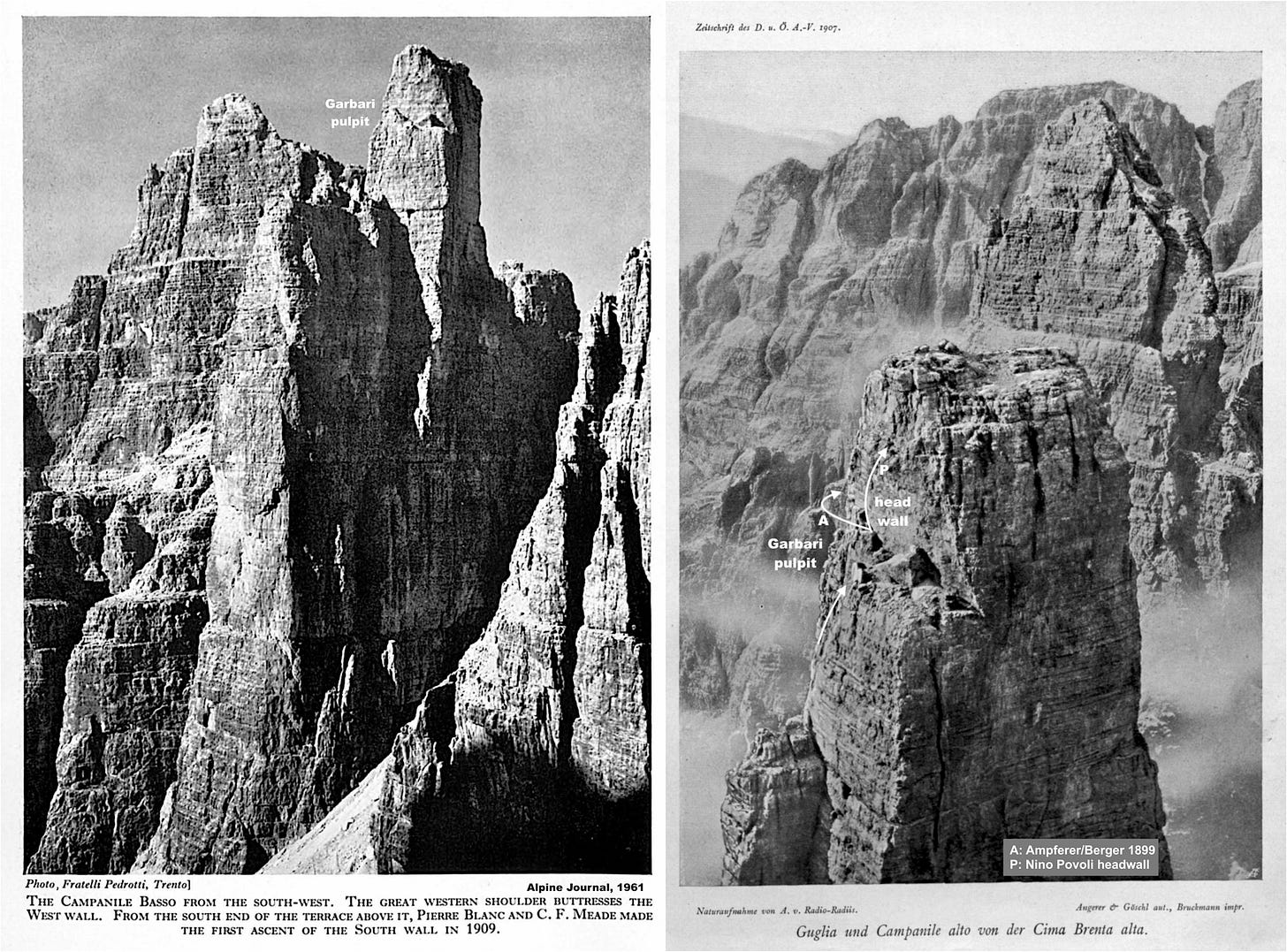

Added Pitons
Subsequent ascents added many pitons to the route. Hans Barth in the 1907 DuÖAV writes, “As smooth as a snake, the wild rock tower rises an estimated 300m. It is the nice thing that modern mountaineers have enough respect for these wild rock monsters that they do not kill it completely with wire rope, stairs and railings, (and only) marking its vulnerable places with iron pin and rope ring.” He notes the second ascent, two climbers from München, had marked a number of these “vulnerable places” with pitons. A fixed rope was also noted in place for one of the sections. On Barth’s third ascent in 1901 with Alfred von Radio-Radiis (what a name!), he describes bringing sharp steel pitons for the ascent, and looking up from the base to a “yellow-red overhang adorned with rope rings” (slings and pitons). Later, unsure of where the route continued, he sees “A hook! So it has to go that way”. At a tiny ledge, he notes, “Our predecessors once again had their weapons in the body of this wild mountain, and we thanked them for this backup option.”
There’s more: on a section mid-way, where the route exits a chimney and moves out onto an exposed face, “The first climbers again tamed the stubborn rock with a hook, so one calms down about climbing the pillar.” For the final bold climbing around the NW corner to the final wall, he writes, “an alcove with rusty hooks in it, above it a brittle outcrop with a hammered piton (footnote) with a weathered hemp rope ring still seems to hold,” followed by a description of the committing moves above.
footnote: the German word Barth uses here is “Stift” (pin/pen/pencil/peg), probably similar to the the British use of the word, “peg”, a generic term used for all things hammered in.
In short, by the third ascent of Campanile Basso, the route had a good number of added pitons, and safer belays. With increasing safety at precarious and exposed belays using artificial anchors (pitons) tied off with cord, short lead falls and swings onto the anchors could be risked. Povoli later returned and fired off the headwall without difficulty, presumably with a safer belay. Any pitons used were generally left in place, and as the route became more popular, Campanile Basso opened many eyes to the wider possibilities in the vertical world, expanding the imagination of climbers willing to adopt the new tools (footnote).
footnote: …along with many controversies debating piton use vs. abuse, which will be discussed in later post. It was still a dangerous bold route for the time: In 1911, a fatal accident is reported. “Mr. Eugen Prosch from Würtzburg fell fatally from the Guglia di Brenta… crossing the northwestern edge at the so-called ‘Garbarikanzel’. Disappeared behind the edge, the companions heard a scream, at the same time a jolt on the rope, which then went slack. The body was cut in two on a sharp rock. Prosch is said to have fallen about 200m.”(1911 Mitteilungen

Campanile Basso, 6th ascent by Piaz (to be continued)
In 1902, Piaz made the 6th ascent of Campanile Basso, (to be continued).
The report above on Campanile Basso was intended to just be an introduction to this chapter on Piaz, to provide context for the state-of-the-art of the time (i.e. a lot more piton use than is often remembered, and probably a lot better technology that people generally imagine) but feel like I should post something today, so here it is for now, likely to be later revised with better segues.
Outline to come (Piaz PartB):
Piaz’s early ascent of Campanile Basso with Franz Wenter, and other wild spires to 1908 including Campanile di Val Montanaia—where Piaz made a famous 37m rappel, the longest overhanging roped descent of the time; Guglia de Amicus—where he used bold rigging techniques and ropework to summit; and Campanile Toro—one of the hardest spires of his career.
Piaz’s speed climbing, solo achievements and innovations.
Ropework and rigging & concepts of Mezzi Artificiali, and state-of-the-art of hardware prior to Fiechtl-design pitons.
Early big walls—Piaz’s road trip up north on his motorcycle—first ascent of the west wall of the Totenkirchl in the Wilder Kaiser.
Really a whole book in English could—and should—be written about Piaz. What becomes clear is that he was a primary pioneer of the means and ways we climb today. For the purposes of this mechanical advantage series, I plan go into detail on Piaz’s climbing career up to his groundbreaking ascent on the Totenkirchl, then probably move on to how the new tools and techniques were employed by other pioneers to establish breakthrough big walls, starting with Dibona around 1908, and eventually to Dülfer and others to wrap up the early years (pre-WWI). Thanks for reading!
Link to Piaz’s autobiography on Kindle
More Campanile Basso notes and images (and Brenta):






ALL LINKS
In the Beginning: Subtle Means and Engines
The Modern Era of Mountaineering (1786)
American Trail Builders, 1800's
Rope Technology in the 19th century
Mizzi Langer -- first advertised rock climbing pitons (Mauerhaken)
Climbing Pitons Early Evolution--part 1a
Climbing Pitons Early Evolution--part 1b
Climbing Pitons Early Evolution--part 1c
Climbing Pitons Early Evolution--part 1d
Climbing Pitons Early Evolution-part 1e
Tita Piaz-Alpinisto Acrobatico (Piaz PartA)







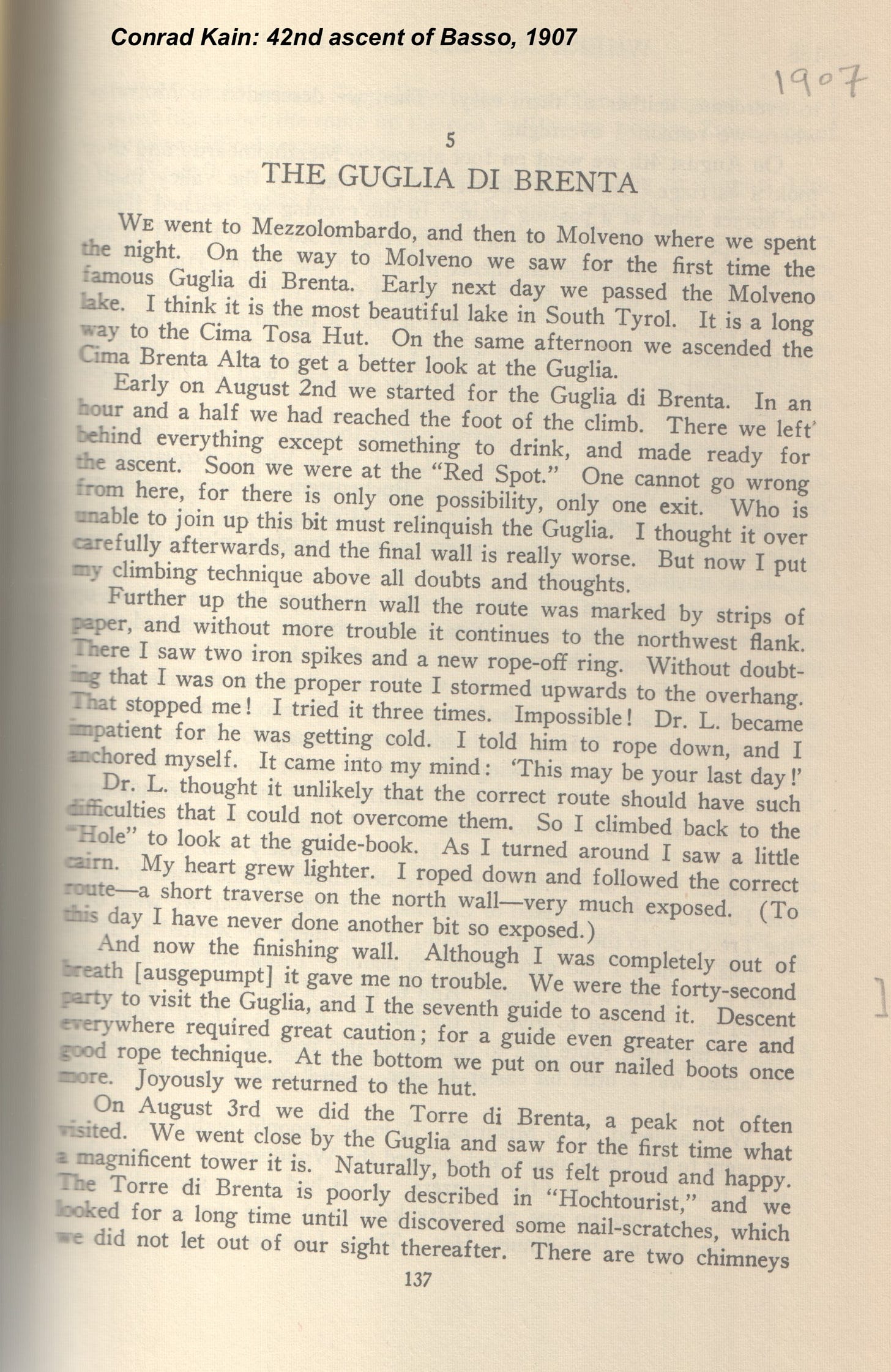
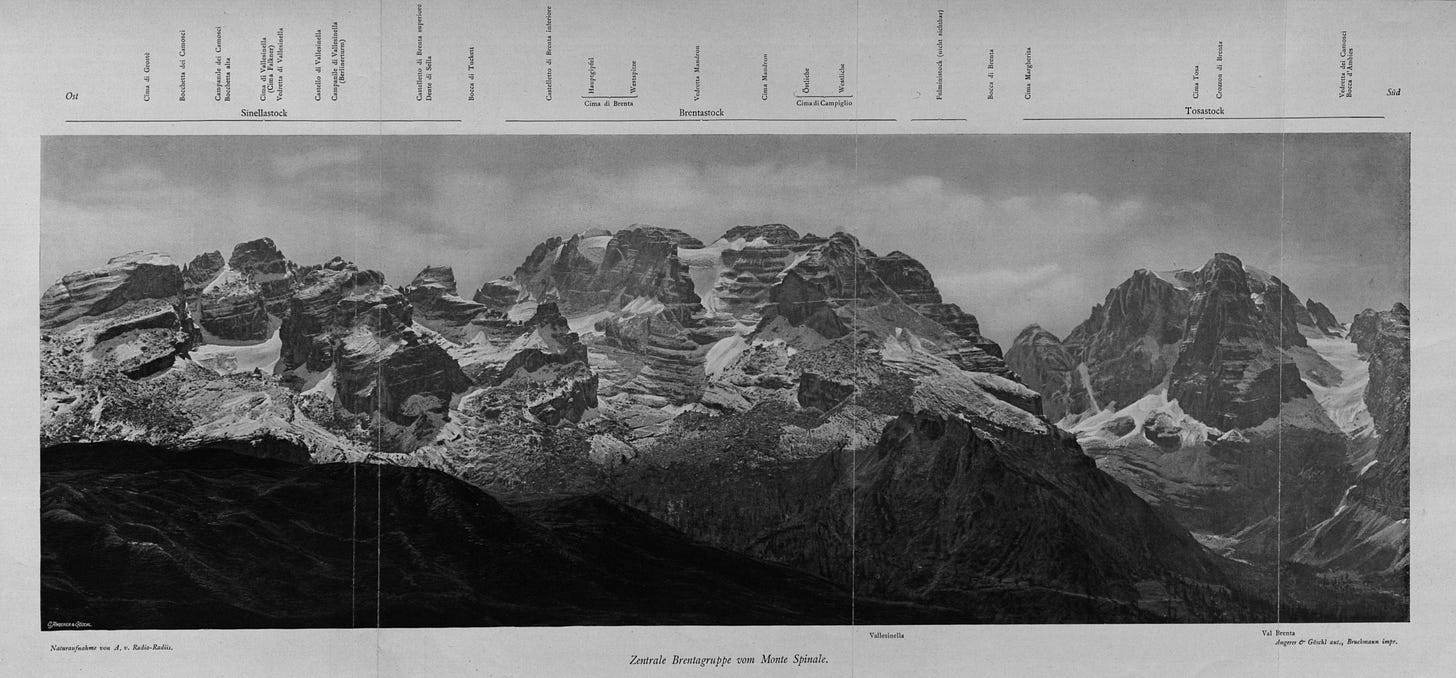
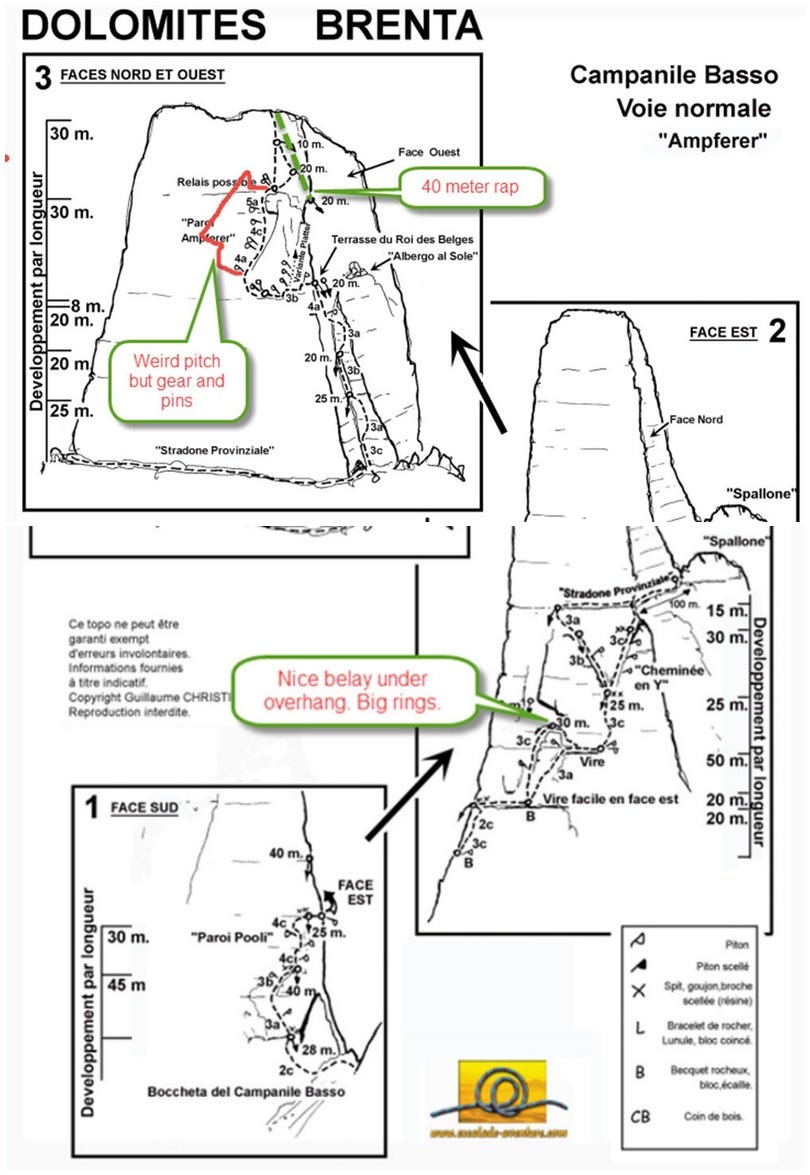
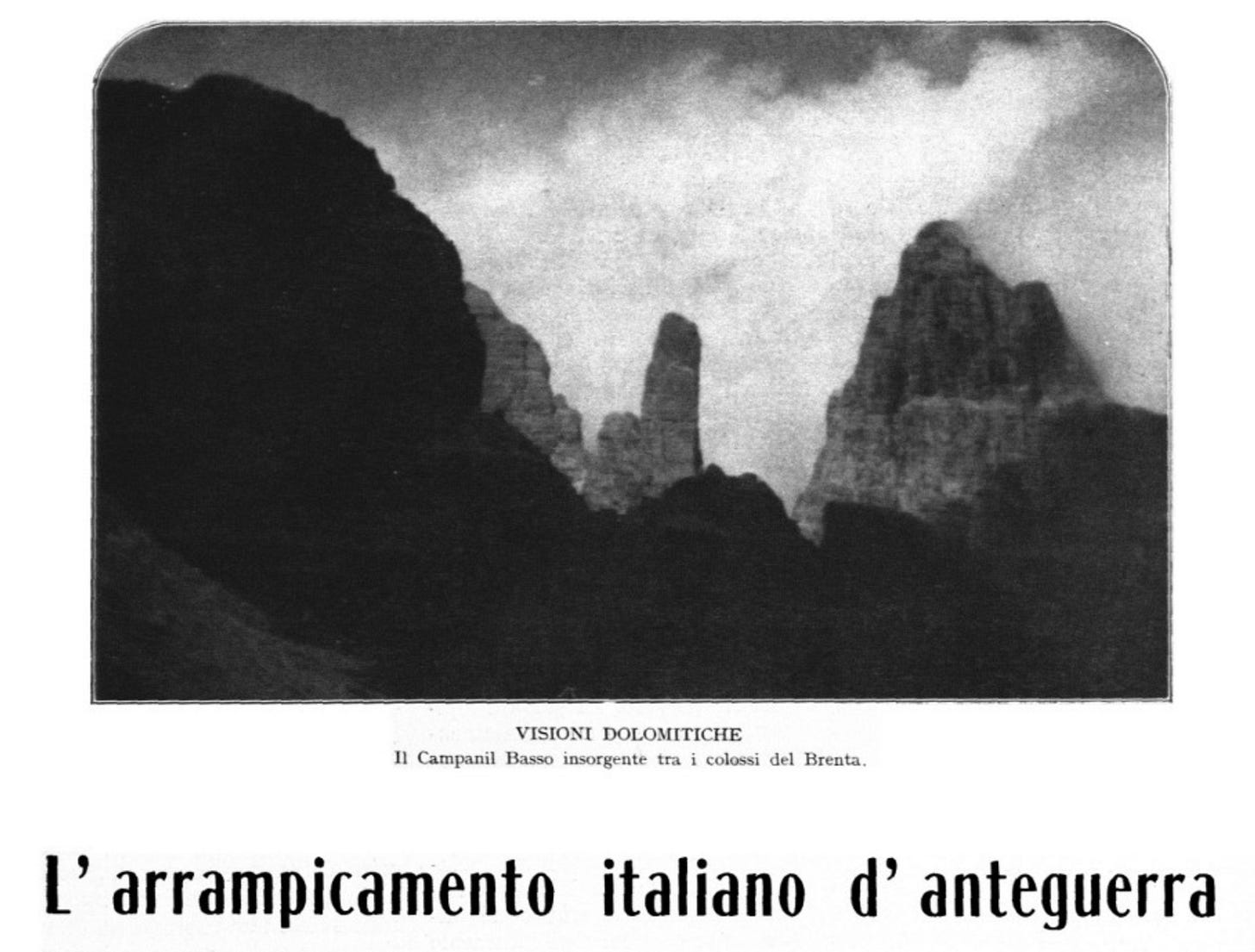

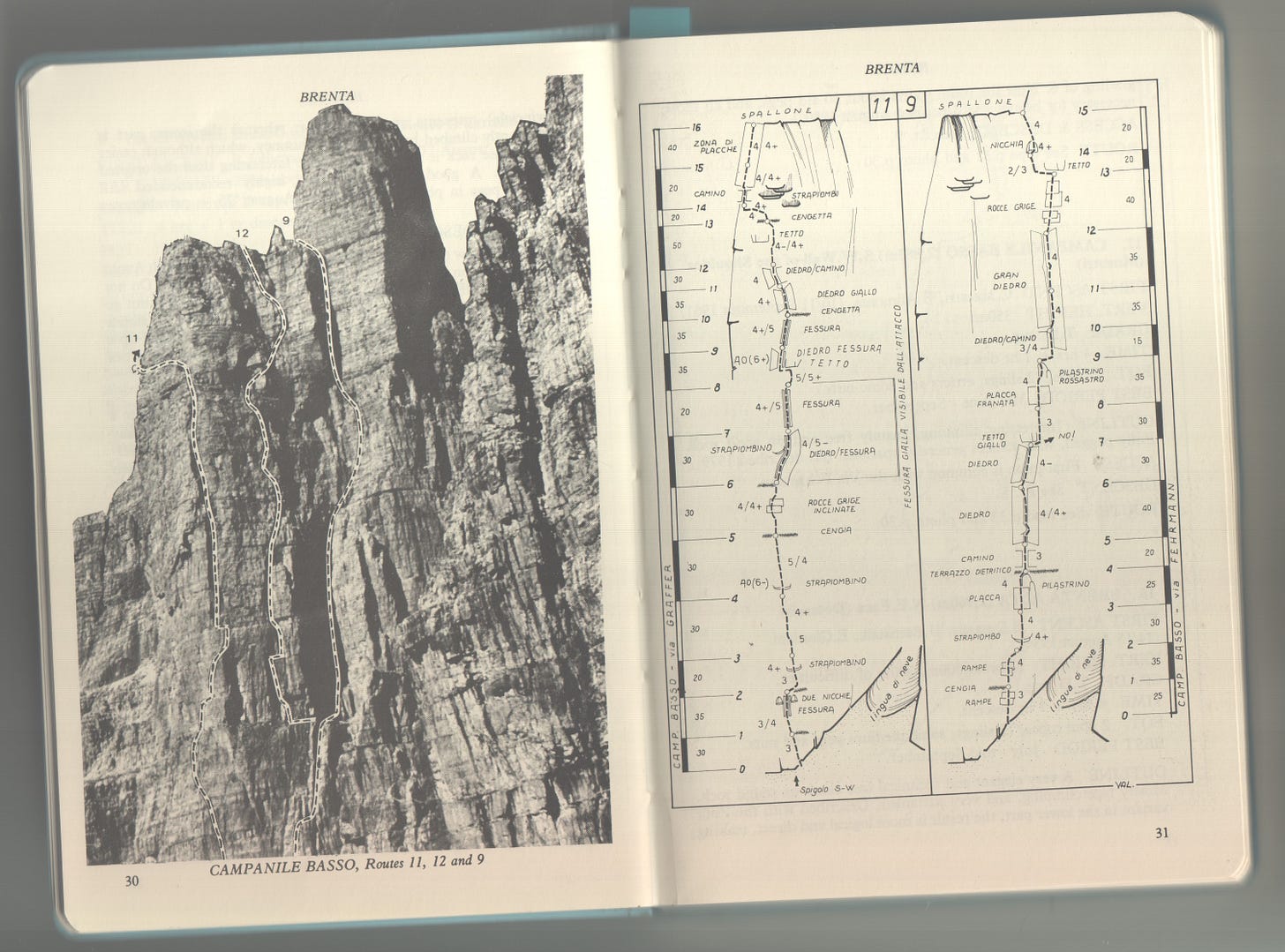
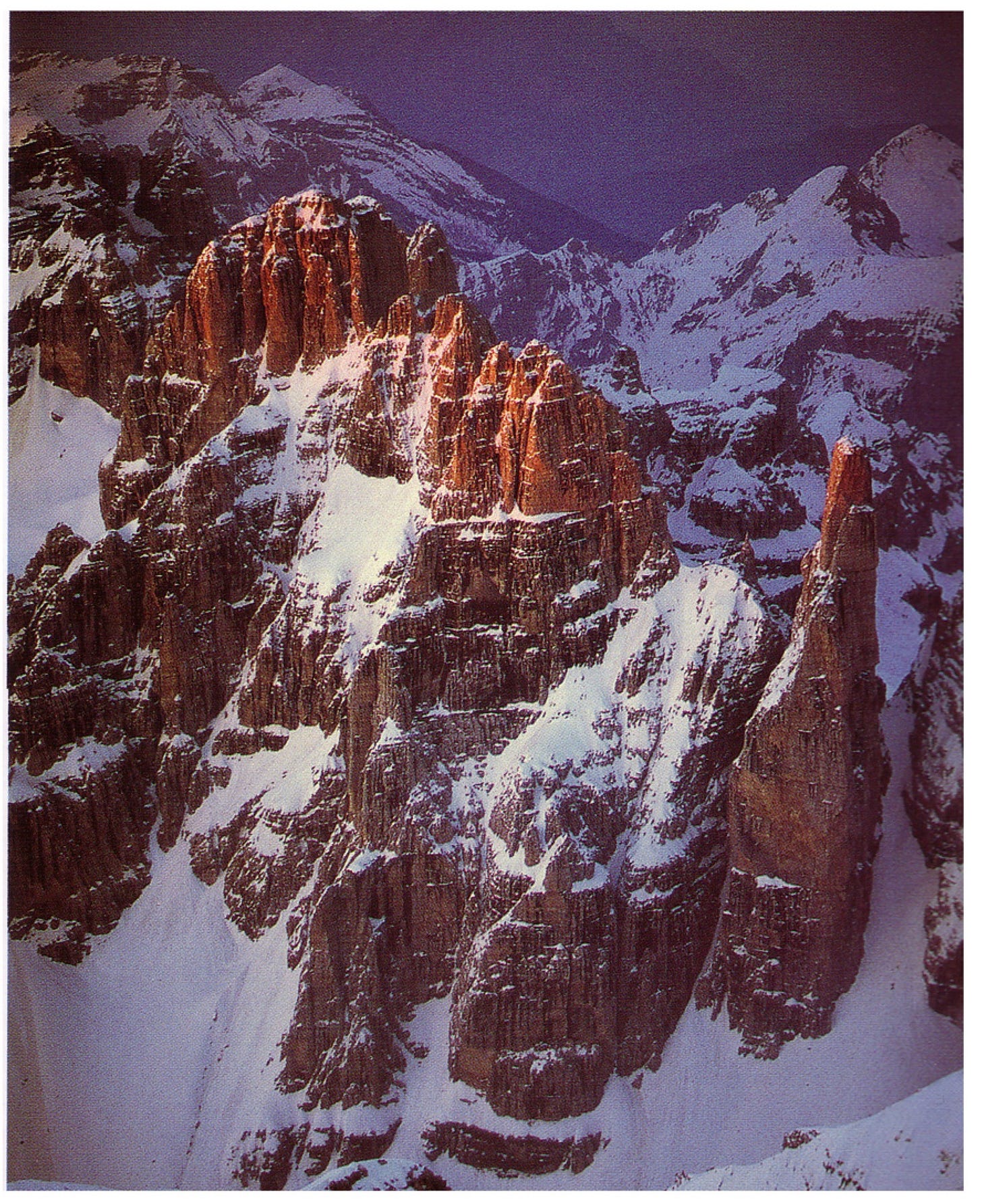

Deuce, Hello from Flagstaff! Wow, this one surprised me. You may know that I started my little company after having an accident descending a snow gully? Well, that snow gully is pictured in your story. Just right of the tower in one of the last pics. My brother Mike and I Climbed the Graffer route on Campanile Basso (he was 18 and I was 22 at the time - 1993) . We didn't finish the last pitches on the final headwall as it was dark already. We descended the rappel and found ourselves at the top of the steep Gully - apparently we should have stopped partway down the last rap to follow a ledge to a different descent. But others had also descended the snow gully as we could see by the tracks - bad choice. Plunge steps worked until I hit a frozen spot and slipped - in my climbing shoes and went for a deadly ride accelerating hundreds of feet down. I had a wild "time dilation" experience where I went through my life and found it easy to accept my own death except for the overwhelming feeling of pain it would cause my girlfriend (now mother of my kiddos) and parents. I think I can see about where I luckily launched off the snow on the "dogleg" and slid along the wall to a stop- backpack and helmet taking much of the impact - and miraculously survived.
In the history of gear development, it's interesting to think how Campanile Basso - nearly a century after being climbed - played a role in my desire to create better gear. I was young and unaware of my hubris and was extremely lucky. And it's also fun to realize by reading your article that Campanile Basso was first completed in 1899. Kahtoola was founded exactly a century later in 1999 - Ha!
Thanks for putting together these interesting pieces...I love getting them.
I hope you're doing great. Hugs from Flag.
Danny G
kahtoola.com